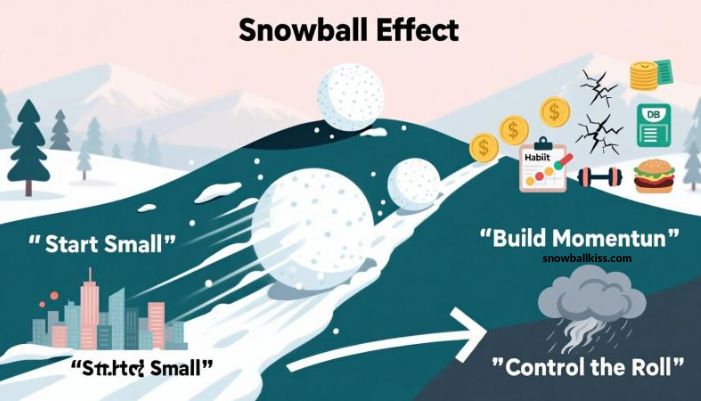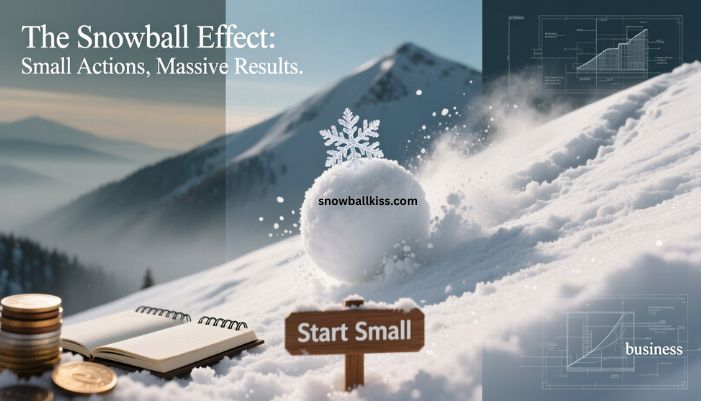The snowball effect is simple. You start small. You keep going. Soon, your progress grows. It moves faster. It gets stronger.
Think of a snowball rolling down a hill. At first, it’s tiny. But as it rolls, it picks up more snow. It gets bigger and faster. That’s how small actions can lead to big changes in your life.
This can help you in many areas. You can use it to save money, build habits, finish big tasks, or improve your health. But it can also work in the wrong way. Small problems can grow too.
In this post, you’ll learn how the snowball effect works, how to use it, and how to stop it when it starts to go wrong.
What Is the Snowball Effect?
The snowball effect happens when something small gets bigger over time. It grows by building on itself. The more it grows, the faster it moves.
You see this in many places. For example:
- You do one small task each day. After a month, your work looks great.
- You put $1 into savings each day. Soon, you have hundreds.
- You start walking five minutes a day. After a few weeks, you’re walking 30 minutes.
This is how progress builds. One step leads to the next. Then another. The snowball grows.
Why It Works
The snowball effect works because actions build on each other.
Small wins give you confidence. They make the next step easier. As you keep going, your results grow.
It works the same way in money, habits, health, and work. One small change leads to more changes. These changes help you do more without much extra effort.
This is how people go from stuck to successful.
Good Snowballs vs Bad Snowballs
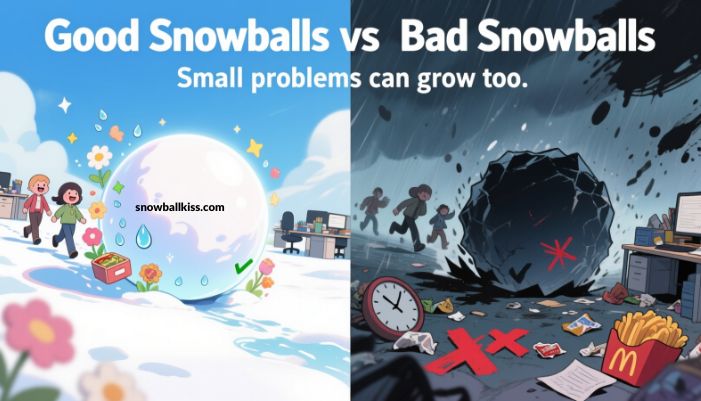
Not all snowballs are good. Small problems can grow too.
Let’s compare.
Good Snowball Example:
- You clean your desk. You feel better. You organize your inbox. You finish more work.
- You drink more water. You feel more energy. You take a walk. You sleep better.
Bad Snowball Example:
- You skip a task. You forget the next one. Your to-do list grows. You feel stressed.
- You eat junk food one day. Then two. Soon, your energy drops. You stop exercising.
Good habits grow. Bad ones grow too. That’s why it’s key to catch small problems early.
Real-Life Examples of the Snowball Effect
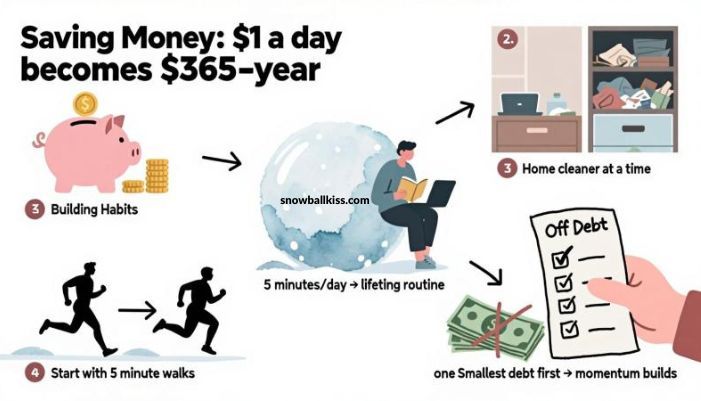
1. Saving Money
Start with $1 a day. It seems small. But after one year, that’s $365. If you add more or invest it, your money grows faster.
This is how people build emergency funds or pay for big goals. The key is starting and not stopping.
2. Paying Off Debt
List all your debts from smallest to biggest. Pay the smallest one first. Once it’s gone, use that money to pay the next one.
Each time you clear a debt, you feel stronger. You move faster. That’s why this method works.
3. Building New Habits
Start with five minutes a day. It could be reading, walking, or learning something.
Once it feels easy, add more time. Soon, it becomes part of your routine.
Small habits lead to big changes.
4. Getting in Shape
Walk for five minutes. Do this every day. After a week, walk ten minutes. Add one small change at a time.
You don’t need to join a gym or run a mile right away. Just keep moving.
5. Cleaning Your Home
Clean one drawer. Then one shelf. Then one room.
When you see progress, it’s easier to keep going. You feel better. The mess gets smaller.
How to Start Your Own Snowball
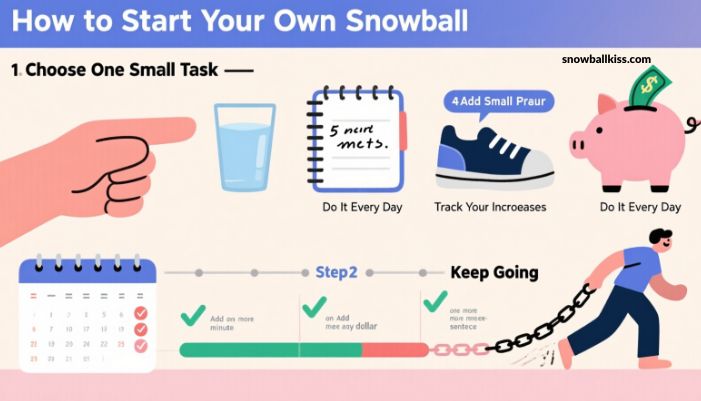
Step 1: Choose One Small Task
Pick something easy. Something you can do today.
- Drink one glass of water.
- Write one sentence.
- Walk for five minutes.
- Save one dollar.
Step 2: Do It Every Day
The goal is to build a chain. One day becomes two. Then ten. Then more.
Keep it simple. Don’t make it hard.
Step 3: Track Your Progress
Use a notebook or an app. Mark each day you do the task.
Seeing your streak grow helps you stay motivated.
Step 4: Add Small Increases
When your task feels easy, do a little more.
- Add one more minute of walking.
- Save one more dollar.
- Write one more line.
Small steps are better than big jumps.
Step 5: Keep Going
You may miss a day. That’s okay. Just start again the next day.
Don’t let one miss stop your whole progress.
How to Stop a Bad Snowball
Bad habits grow the same way. Stop them early. Here’s how.
1. Notice the Pattern
Are small things piling up? Do you feel off? Tired? Behind? That’s a sign.
2. Take One Small Action
Fix something small. Send that email. Fold those clothes. Say sorry. Drink water.
Even a small fix can stop the slide.
3. Replace the Habit
Don’t just stop a bad habit. Add a good one.
- Replace late-night snacks with tea.
- Replace scrolling with reading.
- Replace blaming with fixing.
Build a new snowball.
Read: Snowball Bush: Easy Planting and Care Tips for Any Garden
Tips to Make It Easier
- Keep your goals small and clear
- Set reminders
- Use checklists or trackers
- Celebrate small wins
- Don’t aim for perfect
- Keep going, even if progress feels slow
FAQs
What is the snowball effect in simple words?
It means something small grows bigger over time, like a snowball rolling down a hill.
How can I use it in my life?
Start small. Do it every day. Keep adding to it.
Can it be bad?
Yes. Small problems or bad habits can grow too. Catch them early.
How long until I see results?
Usually after a few weeks. But some changes show faster.
Is it the same as compounding?
Compounding is often used in money. The snowball effect can apply to habits, work, health, and more.
Final Thought
Big changes don’t start big. They start small. One step. One task. One habit. That’s how the snowball effect works.
You don’t need to do everything today. Just do one thing. Then do it again tomorrow. Each small win gives you more power to keep going.
This works for saving money, paying off debt, building habits, or finishing big projects. It also helps stop small problems before they grow.
